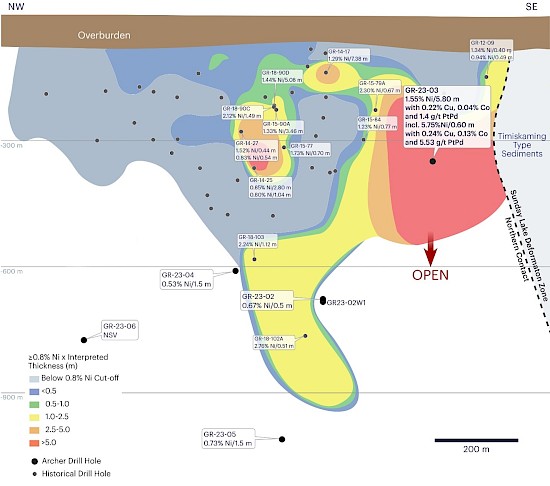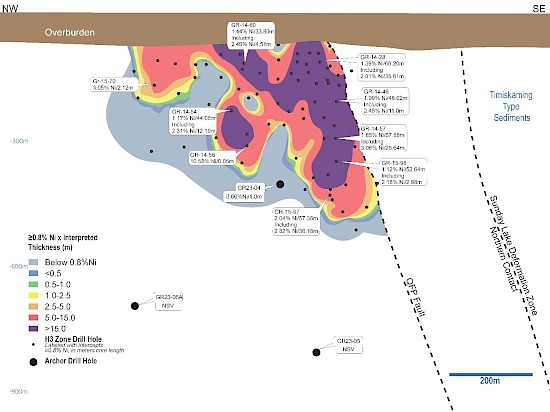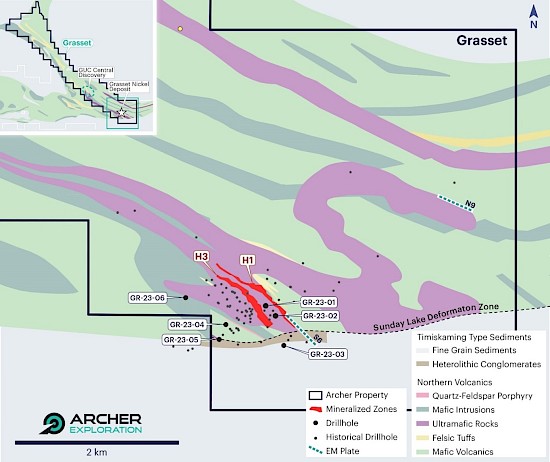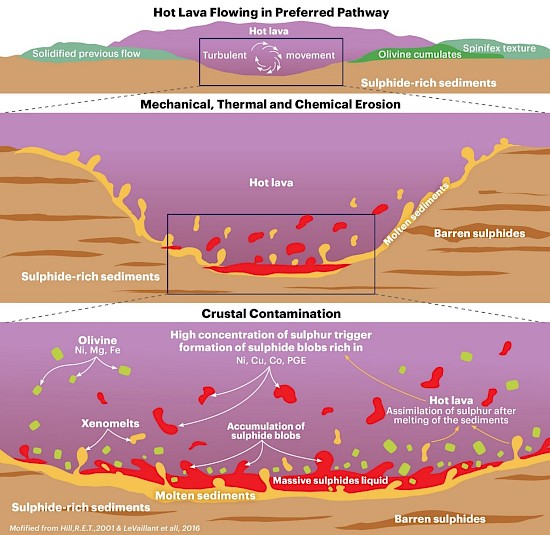News
Archer Exploration Resumes Drilling in H1 Discovery Zone of Grasset Nickel Project
VANCOUVER, BC, November 30, 2023 – Archer Exploration Corp. (CSE: RCHR) (OTCQB: RCHRF) (FSE: 6YR0) (the “Company” or “Archer”) is pleased to announce that it has resumed drilling at its 100% owned Grasset Nickel Project (“Grasset”) in the Abitibi Greenstone Belt of Quebec, Canada.
Highlights
- Drilling has resumed at Grasset and will test shallow depth extensions of the newly discovered nickel-rich massive sulphide zone identified by hole GR23-03 during Summer 2023 drilling
- At a depth of 330 metres, GR23-03 intersected 1.55% Ni, 0.18% Cu, 1.17 g/t Pt-Pd over 5.80 metres, including 5.75% Ni, 0.24% Cu, 5.53 g/t Pt-Pd over 0.60 metres of massive sulphides
- Compilation of new geophysical data with a new geological interpretation based on the re-logging of historical core continues apace and continues to drive the development of exciting new drill targets
- InfiniTEM-XL electromagnetic ground survey identifies new anomaly two kilometres north of Grasset Deposit
- The Company remains fully funded following an oversubscribed $2 million private placement in November 2023
“We are extremely excited to resume drilling at Grasset” commentedTom Meyer, Archer’s President and CEO. “The Fall 2023 campaign will test the newly discovered nickel-rich sulphide mineralization identified by hole GR23-03 and the subsequent down hole electro-magnetic (“DHEM”) surveys will provide invaluable targeting data for extensions to this new zone as we begin planning for a larger winter 2024 drilling program at Grasset. We remain focused on growth and discovery at Grasset as we continue to improve our understanding of this very exciting discovery”.
Fall 2023 Drill Program
The exploration team is on site and drilling has commenced at Grasset, where the Company will explore a newly identified nickel-rich sulphide zone in the southeastern portion of the H1 Horizon. The Fall 2023 drilling program will consist of two holes and approximately 1,200 metres. Hole GR23-07 will target the H1 discovery zone at a depth of approximately 100 metres below the high-grade intercept southeast of hole GR23-03 (Figures 1 and 3), while hole GR23-08 will test for mineralized extensions about 50 metres south-east and 150 metres deeper than GR23-07. Once drilling has completed, DHEM surveys will be conducted to help define this new zone and assist in the planning of an expanded 2,000 metre diamond drilling program in early 2024 that is planned to include further step-out holes that will test for extensions.
The Fall 2023 campaign is designed to test the highly prospective new target zone identified by drill hole GR23-03 and DHEM surveys during the Summer 2023 drilling campaign. In June 2023, the Company reported that hole GR23-03 intersected 1.55% Ni over 5.80 metres, including 5.75% Ni over 0.60 metres of massive sulphides within a large untested area in the southeastern portion of the H1 Horizon. The extent of this newly discovered and completely untested zone has yet to be defined but contains known mineralized intercepts at its periphery as defined by DHEM survey results and historical drill holes (Figure 1).
Table 1: Hole GR23-03 Assay Highlights
| Hole ID | From (m) |
To (m) |
Length (m) |
Ni (%) |
Cu (%) |
Co (%) |
Pt (g/t) |
Pd (g/t) |
| GR23-03 | 403.0 | 408.8 | 5.80 | 1.55 | 0.18 | 0.04 | 0.35 | 0.82 |
| Including | 404.2 | 408.8 | 4.60 | 1.82 | 0.22 | 0.04 | 0.40 | 0.95 |
| Including | 408.2 | 408.8 | 0.60 | 5.75 | 0.24 | 0.13 | 1.68 | 3.85 |
Figure 1 shows the location of hole GR23-03 on a longitudinal section view with nickel metal factor values (% nickel multiplied by estimated thickness) of the H1 Horizon, including holes GR23-04, GR23-05 and GR23-06 that yielded low or non-significant nickel assays.
The longitudinal section shows that the area around the intersection of hole GR23-03 is wide open for mineralized extensions with no previous drill holes below the intercept and no drill holes within 200 metres to the northwest or to the southeast of GR23-03 towards the regional-scale Sunday Lake Deformation Zone which truncates the H1 Horizon.
Figure 1: H1 Horizon Metal Factor Long Section

Figures 2 shows the nickel metal factor longitudinally along the H3 horizon and includes all 2023 program and historical drill holes that have intersected the H3 horizon to date. The steeply plunging thick high-grade channel in the H3 horizon is cut-off by a fault.
Figure 2: H3 Horizon Metal Factor Long Section

Figure 3 is a plan view of the southeastern portion of the Grasset property showing the location of the first six holes drilled in 2023 and the location of newly identified conductive electromagnetic plates (N9 and S6) over a simplified geological interpretation.
Figure 3: Grasset Deposit Planview and 2023 Drilling

InfiniTEM-XL Electromagnetic Ground Survey
A high-powered InfiniTEM-XL electromagnetic surface survey, performed in 2023, has defined a conductive plate (S6 in Figure 3) that is consistent with the high-grade mineralization discovered in hole GR23-03. The interpreted conductive plate is 400 metres by 400 metres and begins 290 metres below surface. A very similar 400-metres by 400-metre conductive plate (N9 in Figure 3) was detected at the same depth approximately two kilometres north-east of S6. Both conductive plates are located at the northern basal contact of an ultramafic sequence. To date, only one shallow hole, almost two kilometres to the northwest, has intersected the ultramafic contact where N9 is located.
As is the case along H1, sulphide-rich sedimentary rocks are sub-parallel and close to the N9 ultramafic contact. This is significant, as in the nickel magmatic metallogenetic model, assimilation of the sedimentary sulphides by the ultramafic magma is the key mechanism to the precipitation and accumulation of the nickel sulphides at the bottom of the ultramafic sequence (Figures 4 and 5). The geological and geophysical similarities between conductive plates S6 and N9 make plate N9 a high priority drilling target that will be tested during the 2024 winter drilling program.
Figure 4: Nickel Formation Model – Grasset Deposit

Figure 5: Nickel Formation Model Detail – Hole GR23-03

2023 Diamond Drill Hole Assays
Holes GR23-04 and GR23-05 were designed to test the down extension of the H3 Horizon at a depth of 600 and 1,000 metres, respectively. The two holes intersected disseminated sulfides where the extension of the H3 and H1 Horizons were expected but did not return any significant nickel values.
Hole GR23-06 was designed to test a deep-seated 3D magnetic anomaly at the north-west limit of the mineralized zone and successfully intersected two separate ultramafic sequences containing zones of disseminated sulphides but did not intersect any significant mineralization.
Table 2: Drillhole Collar Coordinates
| Hole ID | Easting (UTM) |
Northing (UTM) |
Elevation (m) |
Azimuth (°) |
Dip (°) |
Hole Length (m) |
| GR23-01 | 679759 | 5539876 | 291 | 21 | -90 | 446 |
| GR23-02 | 679859 | 5539783 | 291 | 322 | -88 | 759 |
| GR23-02W1 | 679859 | 5539783 | 291 | 322 | -88 | 874 |
| GR23-03 | 679939 | 5539491 | 291 | 30 | -60 | 576 |
| GR23-04 | 679374 | 5537683 | 291 | 45 | -55 | 885 |
| GR23-05 | 679323 | 5539538 | 291 | 50 | -70 | 1,152 |
| GR23-06 | 679020 | 5539776 | 291 | 45 | -62 | 1,104 |
Collar coordinates are UTM Zone 17N
Azimuths and dips are taken from survey record at collar unless otherwise noted
Table 3: Summary of Significant Assay Results – Ni-Cu-Co-PGE
| Hole ID | From (m) |
To (m) |
Length (m) |
Ni (%) |
Cu (%) |
Co (%) |
Pt (g/t) |
Pd (g/t) |
| GR23-01 | No significant mineralization observed | |||||||
| GR23-02 | 514.5 | 515.0 | 0.50 | 0.67 | 0.03 | 0.02 | 0.17 | 0.39 |
| GR23-03 | 358.0 | 358.5 | 0.50 | 0.53 | 0.04 | 0.01 | 0.08 | 0.17 |
| GR23-03 | 403.0 | 408.8 | 5.80 | 1.55 | 0.18 | 0.04 | 0.35 | 0.82 |
| Including | 404.2 | 408.8 | 4.60 | 1.82 | 0.22 | 0.04 | 0.40 | 0.95 |
| Including | 408.2 | 408.8 | 0.60 | 5.75 | 0.24 | 0.13 | 1.68 | 3.85 |
| GR23-04 | 640.5 | 641.5 | 1.00 | 0.60 | 0.11 | 0.02 | 0.28 | 0.55 |
| GR23-04 | 763.5 | 765.0 | 1.50 | 0.53 | 0.05 | 0.01 | 0.12 | 0.28 |
| GR23-05 | 1012.0 | 1013.5 | 1.50 | 0.81 | 0.14 | 0.02 | 0.40 | 0.87 |
| GR23-06 | No significant mineralization observed | |||||||
All lengths are downhole lengths and true widths are expected to be greater than or equal to 50-70% of downhole lengths
Table 4: Summary of Significant Assay Results – Gold
| Hole ID | From (m) |
To (m) |
Length (m) |
Au (g/t) |
| GR23-03 | 98.0 | 98.5 | 0.50 | 1.39 |
| GR23-03 | 110.0 | 111.0 | 1.00 | 0.90 |
| Including | 110.0 | 110.5 | 0.50 | 1.28 |
| GR23-03 | 265.8 | 266.6 | 0.80 | 16.19 |
| Including | 265.8 | 266.1 | 0.30 | 49.10 |
All lengths are downhole lengths and true widths are expected to be greater than or equal to 50-70% of downhole lengths
Ongoing Geophysical Surveys, Geological Modelling and Sonic Drilling Analysis
As a priority objective to expand the Grasset resource and identify new targets along the ultramafic corridor in the south-east part of the property, the Company conducted a 53-kilometre surface InfiniTEM-XL survey and continues to utilize DHEM surveys where applicable. Results from the InfiniTEM-XL and DHEM surveys have been received and an interpretation is underway. In addition, analysis of the final data from the airborne magneto-telluric survey covering the entire 23-kilometre-long property is also progressing. Management is compiling the new data which will be incorporated into a new geological model based on the re-logging of more than 50% of the holes covering the H1 and H3 Horizons.
The Grasset Deposit is situated at the southeastern end of an underexplored 23-kilometre claim block containing abundant favourable ultramafic rocks. A sonic drill program was initiated to sample the base of the glacial till (60-90 metres thick). Such thick overburden, and the lack of outcrop renders the Grasset Deposit and other mineralization blind to conventional surface geochemical sampling techniques. This technique is commonly used with success in exploration campaigns for detecting mineral deposits under thick overburden.
The preliminary results from the sonic drilling program were initially inconclusive but follow-up analysis has demonstrated the potential of this important exploration tool. The Company is conducting a higher resolution analysis of the clasts and heavy minerals within a select group of key samples. The basal till, in the last 8-12 metres, is typically composed of sub-angular mafic to ultramafic clasts with felsic clasts in a silty-sand matrix. Assay results of the fine fraction of the till samples remain outstanding. In addition, the Company is also revising the preliminary interpretation of the glacial movement history over our claim blocks with the guidance of leading experts in Quaternary geology.
The Grasset Project
The Grasset Deposit, discovered in 2012 and located at the southern end of the Grasset Ultramafic Complex, comprises two subparallel, and sub-vertically dipping zones (H1 and H3 horizons) of disseminated to locally semi-massive sulphide mineralization. The H1 and H3 horizons each remain open at depth and along strike to the northwest.
In 2021, an updated mineral resource estimate, using a 2016 drilling cutoff, was completed with an Indicated Mineral Resource Estimate of 5.5 Mt grading 1.53% nickel equivalent (“NiEq”) and an Inferred Mineral Resource Estimate of 217,000 tonnes grading 1.01% NiEq. For additional information regarding Archer’s Grasset Project please refer to the Technical Report entitled “NI 43-101 Technical Report for the Grasset Property, Quebec, Canada” dated effective September 2, 2022, prepared by Carl Pelletier, P.Geo., available under Archer’s profile on www.sedarplus.ca.
The vast majority of the Grasset Ultramafic Complex is underexplored and limited exploration prior to 2016 resulted in the discovery of several significant nickel sulphide showings along the entire 23-kilometre-long belt. Most notable is the GUC Central discovery, 7 kilometres northwest of the Grasset Deposit, which hosts a 950-metre-thick ultramafic sequence with several mineralized horizons of nickel sulphides and a best mineralized intercept of 4.14% Ni over 0.65 metres, within 7.58 metres of 1.05% Ni.
The Grasset Deposit is one of the largest nickel sulphide deposits in Canada’s Abitibi region and the only North American nickel sulphide deposit, with an Indicated Mineral Resource Estimate of more than 50,000 contained tonnes of nickel and an average NiEq grade of over 1.5%, not controlled by a major mining company.
Quality Assurance and Quality Control
Archer implements high-quality industry-standard quality assurance and quality control (“QA/QC”) procedures for its diamond drill programs. Archer’s geologists insert alternating blanks and standards approximately one per every 10 samples collected. Moreover, a blank is added after logged, potentially high-grade mineralized zones with standards additionally inserted within such mineralized zones. Overall, blanks and standards account for approximately 12% of the samples submitted to the lab.
All samples are being assayed at ALS‘s Val d’Or laboratory where duplicates are inserted in the sample sequence at a rate of 1 in 40 samples sequence alternating with standards and blanks to result in a QA/QC insertion rate of about 1 in 10 samples. ALS is independent of the Company. All ALS Geochemistry sites operate under a single Global Geochemistry Quality Manual that complies with ISO/IEC 17025:2017
Qualified Person
The scientific and technical content of this press release has been reviewed and approved by Mr. Jacquelin Gauthier, P.Geo, Vice President, Exploration, who is a "Qualified Person" as defined by National Instrument 43-101 - Standards of Disclosure for Mineral Projects. Mr. Gauthier is satisfied that the analytical and testing procedures used are standard industry operating procedures and methodologies, including sampling, analytical and test data underlying the technical information disclosed in this news release.
About Archer
Archer Exploration is a Canadian Ni-Cu-Co-PGE focused exploration and development company with an extensive portfolio of assets in Quebec and Ontario, Canada. The Company’s flagship asset is the Grasset Project, located within the Abitibi Greenstone Belt, with an Indicated Resource of 5.5 Mt @ 1.53% NiEq. In addition, the Company holds a portfolio of 37 properties and over 300 km2 in the world-class mining district of Sudbury, Ontario.
The Company’s growth strategy is focused on the exploration and development of its nickel sulphide properties within its portfolio. Archer’s vision is to be a responsible nickel sulphide project developer in stable pro-mining jurisdictions. Archer is committed to socially responsible exploration and development, working safely, ethically, and with integrity. For more information, please visit www.archerexploration.com.
Tom Meyer
President & Chief Executive Officer
Tel: +1 866.899.7247 (RCHR)
Email: moc.noitarolpxerehcra@mot
Cautionary Note Regarding Forward-Looking Statements
Neither the CSE nor its Market Regulator (as that term is defined in policies of the CSE) accepts responsibility for the adequacy or accuracy of this release.
The information contained herein contains “forward-looking statements” within the meaning of applicable securities legislation. “Forward-looking information” includes, but is not limited to, statements with respect to the activities, events or developments that Archer expects or anticipates will or may occur in the future. Generally, but not always, forward-looking information and statements can be identified by the use of words such as “plans”, “expects”, “is expected”, “budget”, “scheduled”, “estimates”, “forecasts”, “intends”, “anticipates”, or “believes” or the negative connotation thereof or variations of such words and phrases or statements that certain actions, events or results “may”, “could”, “would”, “might” or “will be taken”, “occur” or “be achieved” or the negative connotation thereof. Forward-looking information and statements contained herein includes, but is not limited to, statements regarding the continued exploration, drilling and anticipated completion of the Fall 2023 campaign; the exploration and testing of shallow depth extensions of the newly discovered nickel-rich massive sulphide zone identified by hole GR23-03; that drilling will provide invaluable targeting data for extensions; the planning of a larger winter 2024 drilling program at Grasset; the exploration potential of the sonic drilling program; and that funding from the Company’s recent private placement is sufficient for operations.
Such forward-looking information and statements are based on numerous assumptions, including among others, that the results of planned exploration activities are as anticipated, the anticipated cost of planned exploration activities, that general business and economic conditions will not change in a material adverse manner, that financing will be available if and when needed and on reasonable terms, that third party contractors, equipment and supplies and governmental and other approvals required to conduct Archer’s planned exploration activities will be available on reasonable terms and in a timely manner. Although the assumptions made by Archer in providing forward-looking information or making forward-looking statements are considered reasonable by management at the time, there can be no assurance that such assumptions will prove to be accurate.
By their nature, forward-looking statements involve known and unknown risks, uncertainties and other factors which may cause our actual results, performance or achievements, or other future events, to be materially different from any future results, performance or achievements expressed or implied by such forward-looking statements. Such factors and risks include, among others: risks associated with the conduct of the Company's mining activities; risks and uncertainties associated with certain exploration and drilling tools and/or measures; regulatory, consent or permitting delays; risks relating to reliance on the Company's management team and outside contractors; risks relating to project financing and equity issuances; risks related to the use of proceeds of the Company’s recent private placement; risks and unknowns inherent in all mining projects; laws and regulations governing the environment, health and safety; the ability of the communities in which the Company operates to manage and cope with the implications of COVID-19; the economic and financial implications of COVID-19 to the Company; operating or technical difficulties in connection with mining or development activities; employee relations, labour unrest or unavailability; the Company's interactions with surrounding communities; the Company's ability to successfully integrate acquired assets; the speculative nature of exploration and development; stock market volatility; conflicts of interest among certain directors and officers; lack of liquidity for shareholders of the Company; litigation risk; the ongoing military conflict in Ukraine and the Middle East; general economic factors (including inflationary pressure); the price of commodities; and the factors identified under the caption "Risk Factors" in the Company’s public disclosure documents.
The forward-looking information contained in this news release represents the expectations of Archer as of the date of this news release and, accordingly, is subject to change after such date. Readers should not place undue importance on forward-looking information and should not rely upon this information as of any other date. Archer does not undertake any obligation to update these forward-looking statements in the event that management’s beliefs, estimates or opinions, or other factors, should change.
